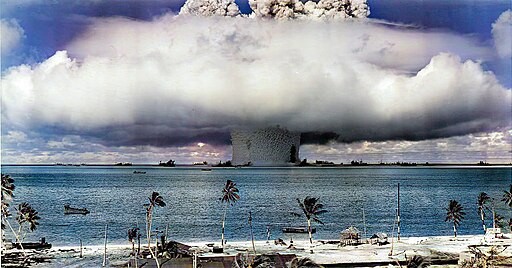In one of the islands in the Pacific lies a "tomb" that contains the pit of radioactive wastes from the atomic bomb tests conducted by the U.S. several decades ago. Known as the Runit Dome, this nuclear coffin shows signs of aging and can potentially cause serious problems in the coming years.

What is the Runit Dome?
During the late 1940s, the U.S. started to test and develop powerful nuclear weapons to gain an advantage over the Soviet Union in the Cold War. The Marshall Islands was identified as a suitable site for testing nuclear weapons for this project due to its low population and distance from other countries and shipping lanes.
The first nuclear bomb was dropped on the islands in 1946. Eight more bombs were detonated near Enewetak Atoll and Bikini Atoll over the next five years. In 1952, the U.S. government started to test larger weapons, including the Castle Bravo, which is 1,000 more powerful than the bombs dropped on Hiroshima and Nagasaki.
In 1963, the Limited Test Ban Treaty was signed, but the U.S. continued to test nuclear weapons on the Marshall Islands, even trying dozens of biological weapons starting in 1968. Within two decades, 67 atomic bombs were detonated on the islands.
By the 1970s, the American government had exhausted its need for testing weapons on the Marshall Islands. However, decades of explosions left huge craters and tons of radioactive waste. The U.S. attempted to clean up the byproducts of its nuclear testing, which led to the construction of the Runit Dome.
A total of 3.1 million cubic feet of radioactive materials was left on the islands, with isotopes with a half-life of 24,000 years. This means that the island will always be toxic for humans. The U.S. Atomic Energy Commission and the Department of Defense devised a plan to gather radioactive debris from Enewetak Atoll and dump it into the Runit crater.
The crater was then sealed with an 18-inch (45 cm) concrete layer, which stretched 377 feet (115 meters) wide. It holds enough radioactive material to fill 35 Olympic-sized swimming pools. This site was called Cactus Dome, while the local residents call it The Tomb.
READ ALSO: Nuclear Weapons Left Bomb Spikes in Our Bodies, Which Can Serve As Universal Time Marker
The Potential Danger of the Nuclear Coffin
The dome was only meant to be a temporary solution, but it has remained for decades and is now starting to show signs of old age. Experts also worry that its contents might also leak into the Pacific Ocean.
In 2019, an investigation by experts from Columbia University revealed that the dome is covered in cracks, which are worsened by rising temperatures in the Pacific. Another study also suggests that some regions of the Marshall Islands have radiation levels comparable to those found near Chernobyl and Fukushima.
Rising sea levels also lap at the shores of the island and erode the concrete. As a result, the dome could bleed radioactive waste into the surrounding soil and waters. By 2030, the sea levels could be 1.2 and 6.3 inches (3 cm and 16 cm) higher than now. By 2100, it is assumed that the dome could be submerged in water.
In 2019, the U.S. government announced its intention to extend an agreement with the Marshall Islands. It promises to provide aid and working rights for the Marshallese in the U.S. in exchange for a secure military presence. In 2023, negotiators from both parties signed a memorandum of understanding on a new Compact of Free Association agreement, which will govern their relations for the next 20 years.
RELATED ARTICLE: Manhattan Project: First Atomic Bomb Test That Turned the Night Into Day
Check out more news and information on Nuclear Weapon in Science Times.














